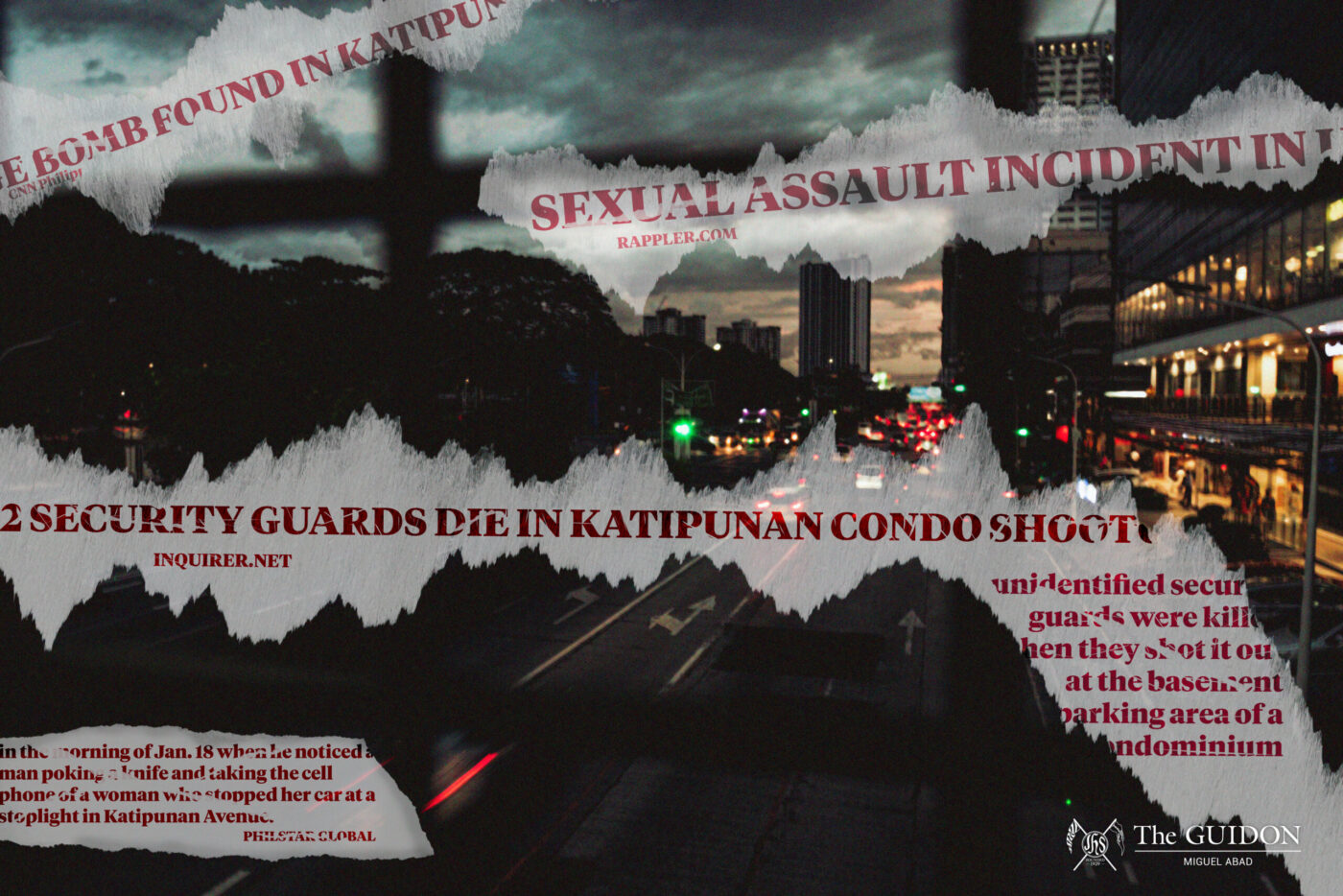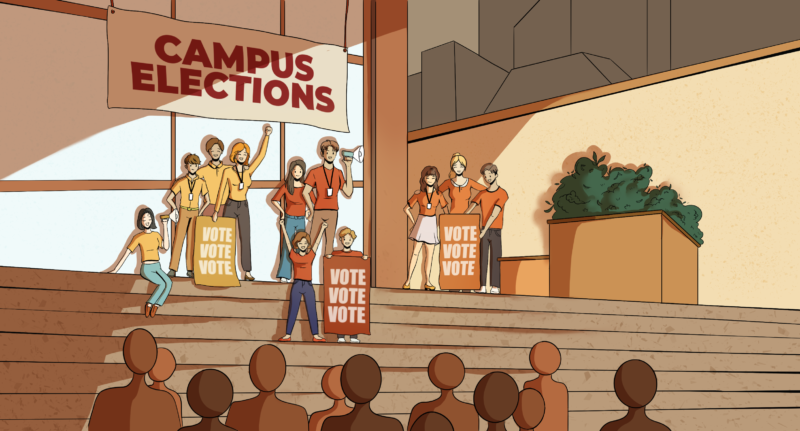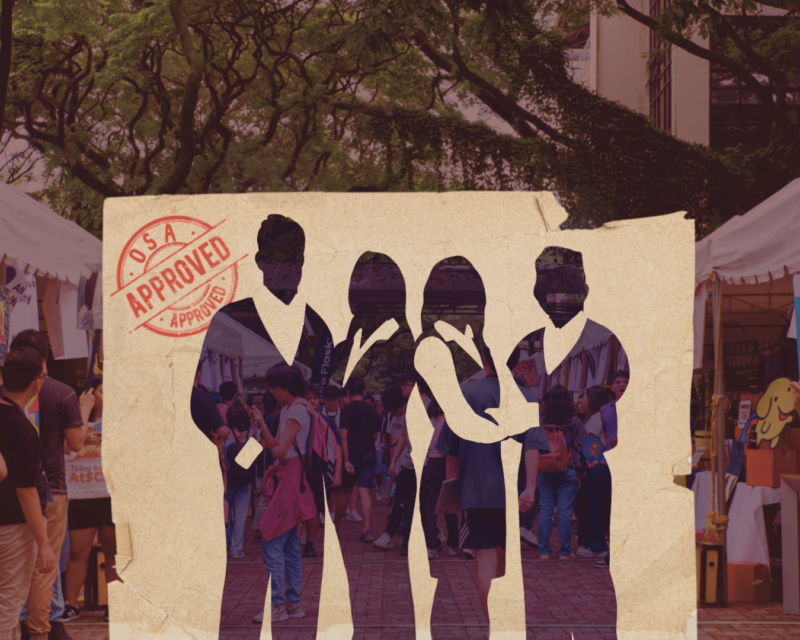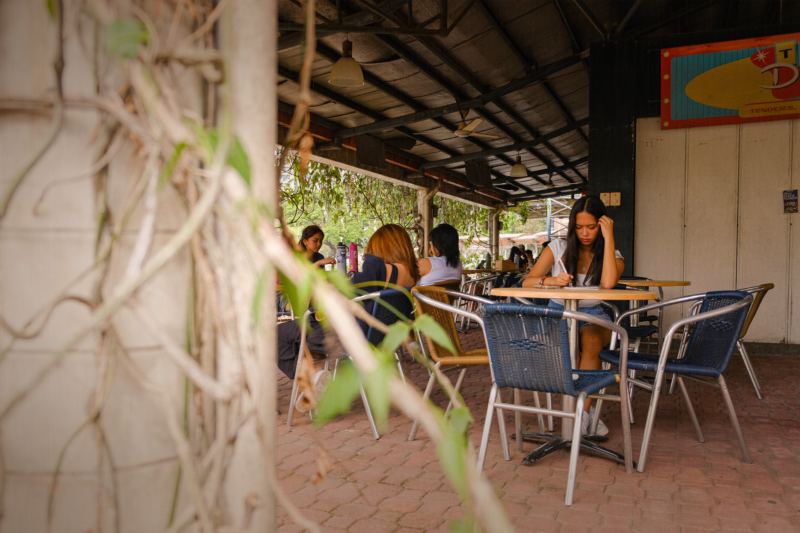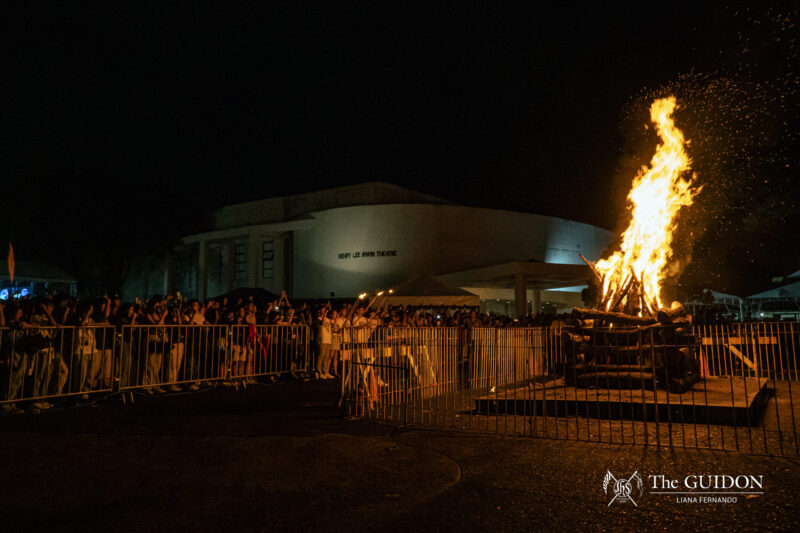AS STUDENTS come from their evening classes or pull an all-nighter at Matteo Up for finals, the lively Ateneo spirit during the day seems to wane at night. With a dark Red Brick Road and a silent SEC walk, trudging the University streets and roads during late hours might be frightening for some students.
Although the Ateneo may seem like a ghost town during the night, students are never alone as guards are stationed by the gates and in some buildings to ensure the community’s safety. Stepping out of the campus, however, welcomes one to an entirely different experience.
With students and civilians alike occupying bars and restaurants scattered across the avenue, Katipunan nightlife becomes busy and alive. However, when these individuals tread the path of going home, they become vulnerable to various threats from perpetrators on the streets.
These recent safety issues pile up in anonymous platforms such as the ADMU Freedom Wall, raising concerns over the effectiveness of security measures observed inside the campus and within the dark sketchy streets of Katipunan. With such crimes transpiring, the role of proper authorities is crucial in safeguarding the entirety of Loyola Heights.
Renewed protocols
Since the University resumed its onsite operations, crimes have also slowly returned to the streets. Over the last year, there have been cases of suspects posing as officers in order to intimidate their victims. Most notably, the shooting case that happened in Areté occurred in the same year, leaving three dead and one injured.
In light of these incidents, the Campus Safety and Mobility Office (CSMO) has further fortified the Ateneo’s safety guidelines by intensifying Campus Access Request procedures. Since then, the University has also requested police visibility on campus during major events, along with the utilization of metal detectors and K-9 units in conducting bag inspections.
For off-campus incidents of theft, however, CSMO Assistant Director Jomer Maghirang notes that processing reports of such cases is not within their jurisdiction. Thus, they offer assistance to students by relaying these reports to the Philippine National Police (PNP) and the authorities of Barangay Loyola Heights.
Situated right in front of the Ateneo, Brgy. Loyola Heights and its authorities remain to be a relevant arm in securing Ateneans’ safety outside the campus. For instance, Kagawad Renz Murao narrated their immediate response during the shooting incident last year. Before the University could call for their assistance, their team of personnel—along with the officers-in-charge—were already stationed in areas near the campus. This allowed them to hear the commotion and rush to chase the suspect.
Additionally, Murao shared their recent coordination with the CSMO in deploying guards by the footbridges, especially those leading to Gates 2.5 and 3.5. During the night, these officers-in-charge position themselves above the footbridges so they can respond to any crime incidents that usually happen there.
As such incidents continue to occur in Katipunan, students are forced to remain vigilant both outside and within campus grounds.
Sense of security
With the return of onsite activities, many students have to frequent the campus and Katipunan roads at night due to their evening classes or extra-curricular events.
Among these students is Viktoria Danikka Galabo (2 BS PSY), who would often endure the rigorous test runs of Loyola Mountaineers until 7 PM. When studying in nearby cafes, she would often have to walk around campus until 11:30 PM.
Regardless of these late hours, Galabo expressed that she has never felt hesitant to leave her dormitories at night. “As a dormer and a woman, I really feel safe walking around campus,” she shares.
Galabo attributes this feeling of safety to a number of security measures put in place within the University. In particular, she points out that guards would usually roam around the campus on motorcycles. Some of them also patrol the dormitory grounds. However, Galabo has observed that there would be fewer guards in the evening.
In terms of exiting and entering the Ateneo gates, Galabo also explains that there are existing protocols in place. For one, dormers have a midnight curfew that they would have to meet to avoid getting reprimanded.
These University safety protocols are communicated to dormers through a dorm kit, which also specifies that whenever leaving the campus overnight or near the curfew, they would have to sign out from their logbook and inform the guards of their expected time of return.
Furthermore, re-entering the campus at late hours requires dormers to have the guards check their IDs for an updated dormer validation sticker, which is also renewed at the start of every semester. As an added layer of security, the dormer’s identity is verified by calling the dormitory itself.
In contrast to this sense of comfort within campus grounds, Galabo feels hesitant to walk within certain areas in Katipunan. She specifies that she usually avoids the inner roads like Esteban Abada or Xavierville, because unlike the main road, fewer cars pass there during the night. Reports of hold-ups and robberies around Katipunan had also contributed to her fear.
Practicing precautions
As possible danger still persists beyond the University’s control, protocols and reminders must be improved to avoid cases of theft and security breaches from reoccurring.
Currently, the coordination between the Ateneo and Brgy. Loyola Heights only relies on their respective contacts and their adherence to their specific protocols, such as bringing suspects to the barangay or to the Police Station 9.
To further advance this collaboration, Kagawad Letty Palanog suggests that the Ateneo administration conduct a student orientation regarding safety measures. According to her, these can include keeping their cell phones and laptops inside their bags and staying responsible when drinking late at night.
Moreover, Murao and Palanog advise students to be more vigilant with the attire of an officer. They emphasize that barangay tanods always have an ID, and usually wear either a blue or white uniform. Along with this, the barangay now requires business establishments to put up CCTV cameras in order to improve safety around the avenue.
Maghirang also reminds students to never give their personal information to strangers and avoid dark areas or walking alone at night. For her personal safety, Galabo shares that she opts to take a tricycle instead when going from one location to another during late hours.
In the end, one’s safety can be widely determined by their vigilance and individual adherence to precautions. However, it is also heavily influenced by systems and policies in place, underscoring the need for combined efforts between relevant institutions within and beyond the University.
With this, Murao calls on school authorities and student leaders to strengthen their collaboration for more improved safety mechanisms. “‘Yung mga nakakausap ninyo sabihin niyong mag-ingat, sabihin niyo ‘yung mga precaution na dapat gawin. […] Tulungan na lang tayo,” he said.
(Remind the people that you talk to that they should be careful, and inform them of the precautions that they must follow. […] Let’s help each other.)
In case of any emergencies, the following hotlines must be recorded: 02-86666603 (Barangay Loyola Heights), 02-84343942 (Anonas Police Station), and 0917-562-8641/0999-992-5715 (Ateneo Security).

